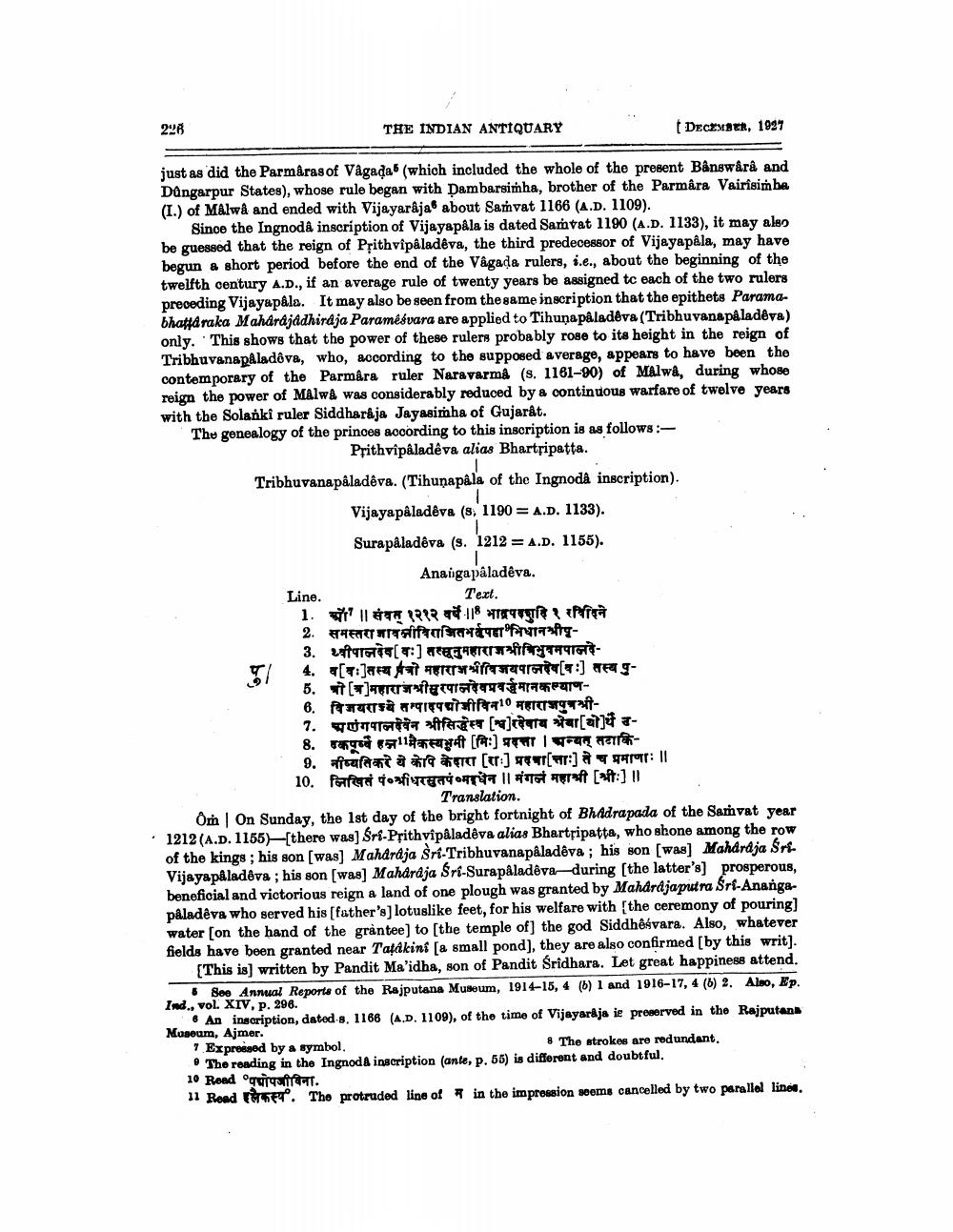________________
298
THE INDIAN ANTIQUARY
DECEMBER, 1927
just as did the Parmaras of VAgada (which included the whole of the present Bânswårå and Dungarpur States), whose rule began with Dambarsimha, brother of the Parmâra Vairisimba (I.) of Malwâ and ended with Vijayaraja about Samvat 1166 (A.D. 1109).
Since the Ingnodâ inscription of Vijayapála is dated Samvat 1190 (A.D. 1133), it may also be guessed that the reign of Prithvipaladeva, the third predecessor of Vijayapala, may have begun a short period before the end of the Vâgada rulers, i.e., about the beginning of the twelfth century A.D., if an average rule of twenty years be assigned tc each of the two rulers preceding Vijayapâla. It may also be seen from the same inscription that the epithets Paramabhattaraka Maharajadhirdja Paramésvara are applied to Tihunapaladēva (Tribhuvanapaladêya) only. This shows that the power of these rulers probably rose to its height in the reign of TribhuvanapAladôva, who, according to the supposed average, appears to have been the contemporary of the Parmara ruler Naravarma (s. 1161-90) of Malwê, during whose reign the power of Malwê was considerably reduced by & continuous warfare of twelve years with the Solanki ruler Siddharåja Jayasinha of Gujarat. Thu genealogy of the princes according to this inscription is as follows:
Prithvipâladêva alias Bhartripatta. Tribhuvanapâladêve. (Tihunapala of the Ingnodâ inscription).
Vijayapåladêva (8, 1190 = A.D. 1133). Surapaladêva (s. 1212 = A.D. 1155).
Anangapaladêva. Line.
Text. 1. r II T RI 18 augit fra 2. समस्तरामावलीविराजितभपहाभिधानश्रीपू3. v :) TEA T T96
[:]ara terpis :) TRE5. [w]nerrutt
u r6. Petra Totaftfalo WT7. UITERA fare []cara star[it]# - 8. regat 11TH (14:)
a gan - 9. fofaat dan T (TT:) *[T:] 9: || 10. fafar torfieAYO Tia 11 Torf (aft:] ll
Translation. Om On Sunday, the 1st day of the bright fortnight of Bhadrapada of the Samvat year 1212 (A.D. 1165)[there was) Sri-Prithvipaladeva alias Bhartripatta, who shone among the row of the kings ; his son (was) Maharaja Šri-Tribhuvanapaladêva; his son (was] Maharaja ŚrVijayapaladdva ; his son (was) Maharaja Sri-Surapaladêva-during the latter's) prosperous, beneficial and victorious reign a land of one plough was granted by Mahardjaputra Sri-Anangapåladeva who served his (father's) lotuslike feet, for his welfare with the ceremony of pouring) water (on the hand of the grantee) to (the temple of] the god Siddhêsvara. Also, whatever fields have been granted near Tațakini [a small pond), they are also confirmed [by this writ].
[This is) written by Pandit Ma'idha, son of Pandit Sridhara. Let great happiness attend.
5 See Annual Reports of the Rajputana Museum, 1914-15, 4 (6) 1 and 1916-17, 4 (6) 2. Also, Ep. Ind., vol XIV, p. 296.
* An inscription, dated 8. 1166 (A.D. 1109), of the time of Vijayaraja ie preserved in the Rajputana Museum, Ajmer. 7 Expressed by a symbol
& The strokes are redundant. The reading in the Ingnod A inscription (ante, p. 56) is different and doubtful. 10 Road guitar. 11 Read TT. Tho protruded lino of in the impression seems cancelled by two parallel line.




